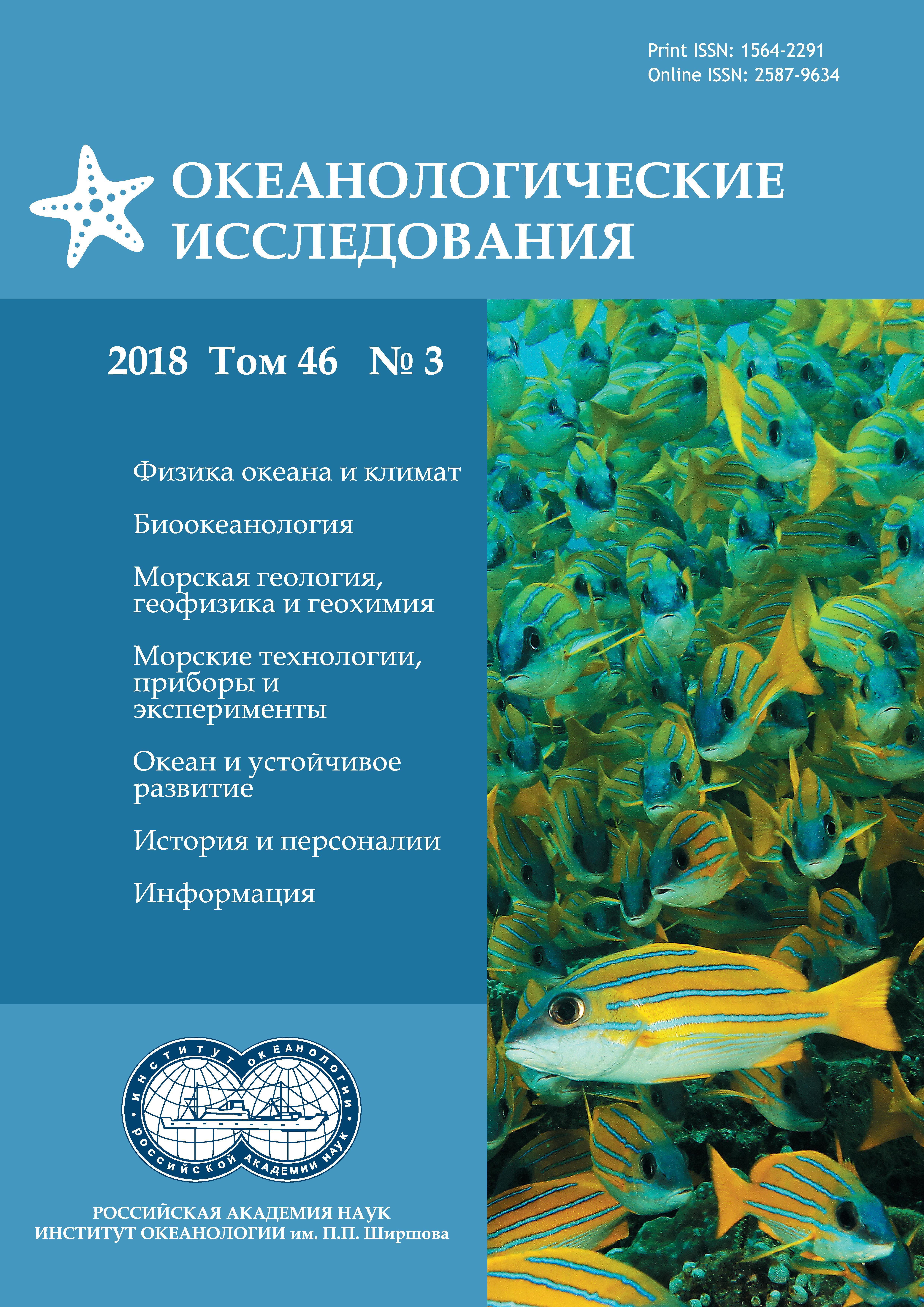ФРОНТЫ В ЖЕЛТОМ И ВОСТОЧНО-КИТАЙСКОМ МОРЯХ: ТЕМАТИЧЕСКОЕ ИССЛЕДОВАНИЕ
Аннотация
Для обновления и расширения знаний о структуре, мезомасштабных особенностях, сезонной и межгодовой изменчивости фронтов в Желтом и Восточно-Китайском морях использованы среднемесячные спутниковые измерения температуры поверхности моря (ТИМ) с высоким разрешением (данные PATHFINDER) за период 1982-2009 гг., а также отдельные спутниковые инфракрасные и видимые изображения. Представлены особенности общей циркуляции, процессов фронтогенеза и изложена феноменология фронтов. Документирована сезонная изменчивость отдельных наиболее значимых локальных фронтов. Основной результат заключается в том, что при применении климатологического осреднения фронты на границе Восточно-Китайского моря (Тайваньский фронт, фронтальная зона Куросио и Цусимский) образуют единую доминирующую фронтальную структуру. Эта структура протяженностью около 1200 км простирается вдоль континентального шельфа от о. Тайвань до о. Цусима и отделяет продуктивные морские воды от олиготрофных океанических вод. Эта фронтальная структура проявляется как устойчивая когерентная особенность в течение всего года. Однако она проявляет сезонную изменчивость интенсивности градиента ТИМ. Максимальная интенсивность наблюдается в холодное время года (январь- апрель), когда контраст ТИМ между теплыми водами Куросио и охлаждающими водами Восточно-Китайского моря максимален. Для изучения долговременной изменчивости этой фронтальной системы рассчитан максимальный меридиональный градиент ТИМ в районе фронтальной зоны Куросио в феврале. Полученные результаты свидетельствуют о наличии выраженной межгодовой изменчивости градиента ТИМ с периодами, сопоставимыми с ENSO (4-5 лет). Найдена статистически значимая положительная корреляция (R = 0.57, р < 0.01) между градиентом ТИМ и мультивариативным индексом ENSO (MEI).
Литература
- Beardsley R.C., Limeburner R., Ни D. Structure of the Changjiang River plume in the East China Sea during June 1980. Proc. of the Int. Symp. on Sedimentation on the Continental Shelf with Special reference to the East China Sea. 1983. 12-16 Apr. Huangzhou, China // Beijing: China Ocean Press. 1983. Vol. 1. P. 243–260.
- Belkin I.M., Cornillon P. SST fronts of the Pacific coastal and marginal seas // Pacific oceanography. 2003. Vol. 1(2). P. 90–113.
- Belkin I.M., Cornillon P., Sherman K. Fronts in Large Marine Ecosystems // Prog. Oceanogr. 2009. DOI:10.1016/j.pocean.2009.04.015.
- Byun S.K., Chang K.I. Tsushima Current Water at the Entrance of the Korea Strait in Autumn // Prog. Oceanogr. 1988. Vol. 21. P. 295–306.
- Casey K.S., Brandon T.B., CorniUon P., Evans R. The Past, Present and Future of the AVHRR Pathfinder SST Program // Oceanography from Space: Revisited, eds. V. Barale, J.F.R. Gower, and L. Alberotanza, Springer, 2010. DOI: 10.1007/978-90-481-8681-5-16.
- Chen C.T.A. Chemical and physical fronts in the Bohal, Yellow and East China Seas // Journal of Marine Systems. 2009. Vol. 78. P. 394–410. D01:10.1016/j.jmarsys.2008.11.016.
- Hickox R., Belkin I.M., Cornillon P., Shan Z. Climatology and seasonal variability of ocean fronts in the East China, Yellow and Bohai Seas from satellite SST data // Geophysical Research Letters. 2000. Vol. 27(18). P. 2945–2948. D01:10.1029/1999GL011223.
- Hu Dunxin. Upwelling and sedimentation dynamics. 1. The role of upwelling in sedimentation in Huanghai Sea and East China Sea - a description of general features // China J. Oceanol. Limnol. 1984. Vol. 2(2). P. 12–19.
- Kazmin A.S. Study of Fronts in the Yellow and East China Seas from Satellite Data // Soviet Journal of Remote Sensing. 1993. Vol. 10(3). P. 495–506.
- Kazmin A.S. The Frontal System at the Boundary of the East China Sea: Its Variability and Response to Large-Scale Atmospheric Forcing // Oceanology. 2016. Vol. 56. No. 4. P. 465–469.
- Kazmin A.S. Variability of the climatic oceanic frontal zones and its connection with the large- scale atmospheric forcing // Progress in Oceanography. 2017. Vol. 154. P. 38–48.
- Kostianoy A.G., Zatsepin A.G. The West African coastal upwelling filaments and cross-frontal water exchange conditioned by them // J. Mar. Sys. 1996. Vol. 7(2-4). P. 349–359. DOI: 10.1016/0924-7963(95)00029-1.
- Kuroda Y., Нага T., Misumi A. Across the East China Sea Shelf Edge by an Underwater Sliding Vehicle with CTD Sensors // Progr. Oceanogr. 1988. Vol. 21. P. 401–416.
- Lie H.J. Tidal fronts in the Southeastern Hwanghae (Yellow Sea) // Continental Shelf Res. 1989. Vol. 9(6). P. 527–546.
- Mao Hanil, Hu Dunxin, Zhao Baoren. Mesoscale Eddy Movement in the Northern East China Sea // Chin. J. Oceanol. Limnol. 1983. Vol. 1(3). P. 237–247.
- Milliman J.D., Ya Hsueh, Hu Dunxin. Tidal Phase Control of Sediment Discharge from Yangtze River // Estuarine, Coastal and Shelf Sci. 1984. Vol. 19. P. 119–128.
- Pan J., Zu D., Xu J. The structure of fronts and their causes in the coastal upwelling area off Zhejiang // Acta Oceanol. Sin. 1987. Vol. 6(2). P. 177–189.
- Sha X., Xu B. Quick reporting state of fishery and sea on the East China Sea and Yellow Sea with NOAA // Proc. of IGARSS’88 Symp. 1988. Edinburg, Scotland, 13–16 Sept. Edinburg: 1988. P. 1405–1408.
- Wolter K., Timlin M.S. El Nino/Southern Oscillation behaviour since 1871 as diagnosed in an extended multivariate ENSO index (MEI.ext) // Int. Journal of Climatology. 2011. Vol. 31(7). P. 1074–1087. DOI: 10.1002/joc.2336.
- Xu B., Sha X. A preliminary study on nearshore water in China with NOAA satellite images // Proc. of IGARSS’88 Symp. Edinburg, Scotland, 13–16 Sept. 1988. Edinburg: 1988. P. 1413–1416.
- Zheng Q., Klemas V. Determination of winter temperature patterns, fronts and surface currents in the Yellow Sea and East China Sea from satellite imagery // Rem. Sens. of Environ. 1982. Vol. 12. P. 201–210.
Передача авторских прав происходит на основании лицензионного договора между Автором и Федеральным государственным бюджетным учреждением науки Институт океанологии им. П.П. Ширшова Российской академии наук (ИО РАН)













